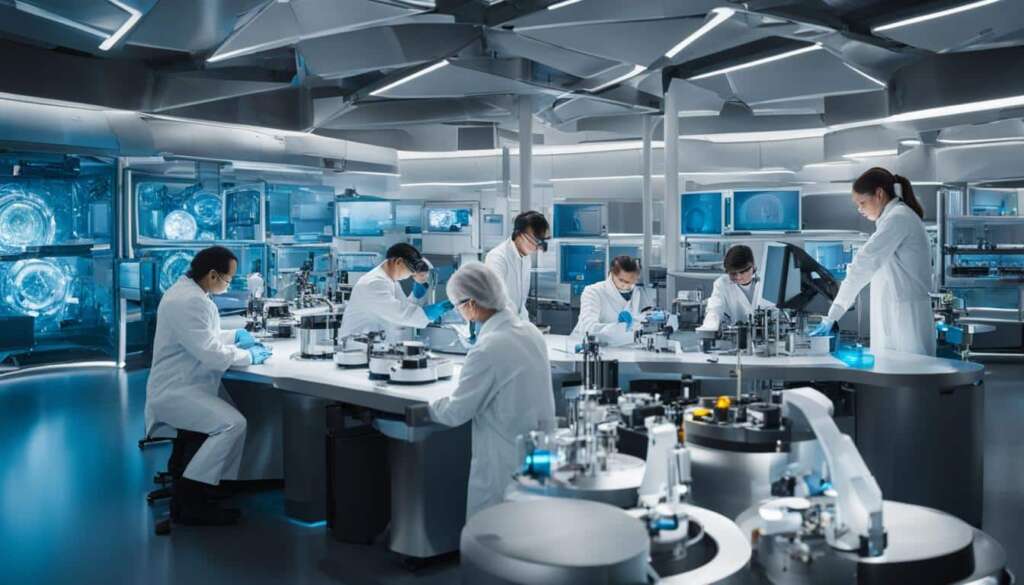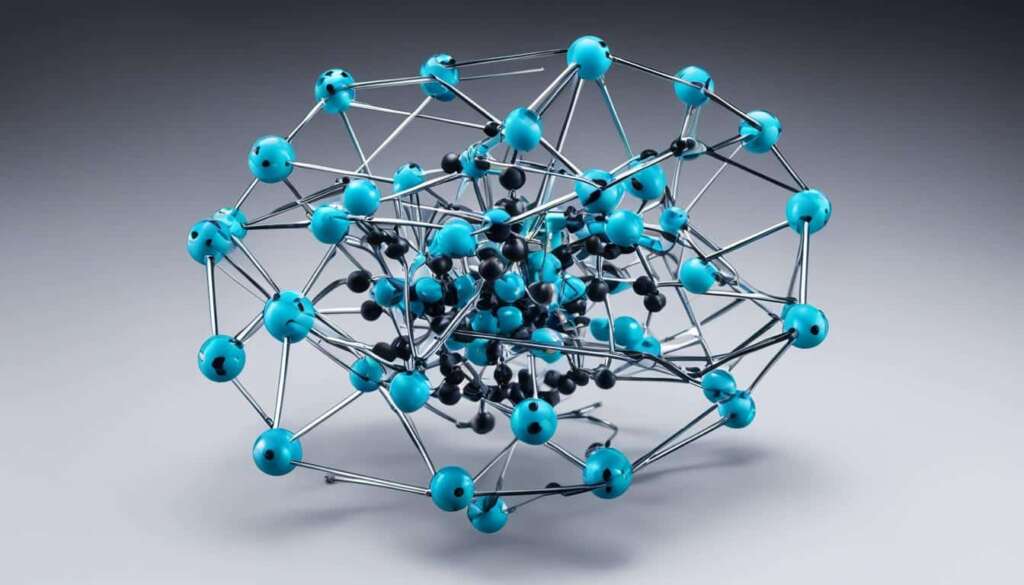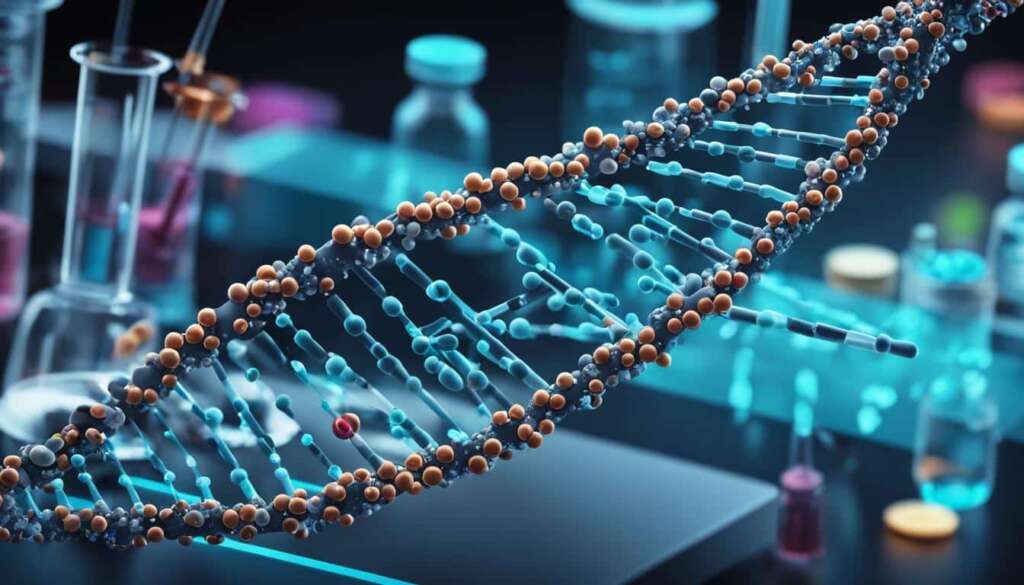Table of Contents
Nanotechnology, with its wide applications in science, medicine, engineering, computing, and robotics, brings both advantages and disadvantages. Understanding the pros and cons of nanotechnology is crucial for making informed decisions about its implementation and development.
Key Takeaways:
- Nanotechnology offers advantages in various fields such as manufacturing, energy, medicine, and electronics.
- Advancements in nanomaterials allow for the development of superior products and manufacturing techniques.
- Nanotechnology can revolutionize energy production and the electronics industry, leading to more efficient power sources and enhanced electronic devices.
- In the medical field, nanotechnology holds promise for advancements in surgeries, drug production, and infection detection.
- While nanotechnology brings numerous benefits, it also poses potential risks, including environmental effects, economic disruptions, security threats, and potential health risks.
Manufacturing Advantages of Nanomaterials
Nanotechnology is revolutionizing manufacturing by creating new materials with unique properties and exceptional possibilities. Nanotubes, nanoparticles, and aerogels are some of the innovative materials that have emerged from nanotechnology research. These materials offer a range of advantages, such as enhanced strength, increased conductivity, and improved chemical reactivity. By harnessing these properties, manufacturers can develop novel techniques and superior products across different industries.
One of the most promising aspects of nanotechnology is the potential to construct new materials and objects through nanobots and nanofactories. These miniature robotic systems can manipulate matter at the atomic and molecular scale, allowing for precise manufacturing processes and the production of complex structures that were previously unimaginable.
The manufacturing advantages of nanomaterials are evident in various sectors. In the electronics industry, nanomaterials enable the creation of smaller, more efficient devices with enhanced performance. For example, nanoscale transistors and memory devices can be produced, leading to faster and more powerful computers. Nanomaterials also play a crucial role in improving energy production and storage. By using nanotechnology, solar panels can be made more cost-effective, and energy storage devices can have higher energy density and faster charging capabilities.
| Advantages | Examples |
|---|---|
| Enhanced strength and durability | Nanocomposites used in aerospace industry for lighter and stronger components |
| Improved conductivity | Nanoparticles integrated into electronic circuits for faster data transfer |
| Enhanced reactivity | Nanocatalysts for more efficient and selective chemical reactions |
| Precise control over material properties | Nanostructured coatings for corrosion and wear resistance |
Additionally, nanomaterials have applications in the aerospace and automotive industries, where lightweight yet strong components are essential for fuel efficiency and performance. Nanotechnology allows for the development of nanocomposites, which combine nanoscale reinforcements with traditional materials to achieve superior strength and durability.
“Nanotechnology has opened up new possibilities for manufacturing by providing a toolkit of materials and processes that can be tailored to meet specific industry needs.” – Dr. Emily Johnson, Director of Nanotechnology Research Institute
The manufacturing advantages of nanomaterials extend beyond the products themselves. By using nanotechnology, manufacturers can reduce waste and energy consumption during the production process. With precise control over material properties, nanotechnology enables efficient use of resources and improved sustainability.
As nanotechnology continues to advance, it holds the potential to revolutionize manufacturing by introducing innovative materials, processes, and technologies. By harnessing the unique properties of nanomaterials and leveraging nanobots and nanofactories, manufacturers can unlock new opportunities and drive advancements across industries.
Energy and Electronic Advantages
Nanotechnology has paved the way for remarkable advancements in both the energy and electronics sectors. Its application in these fields offers numerous advantages, driving innovation and shaping the future of technology.
Solar Power Revolution
One significant benefit of nanotechnology in the energy industry is its ability to make solar power more accessible and economical. By utilizing nanomaterials, the cost of constructing solar panels can be greatly reduced, making solar energy a more viable option for widespread adoption. This breakthrough has the potential to accelerate the transition to clean and renewable energy sources, contributing to a greener and more sustainable future.
Enhanced Electronic Devices
Nanotechnology also plays a crucial role in improving electronic devices by enabling the construction of circuits on an atomic level. This allows for the creation of smaller, more powerful, and energy-efficient electronic components, leading to advancements in various electronic devices such as display screens and lighting systems. The precision and control offered by nanotechnology enable manufacturers to produce electronics with enhanced capabilities and performance, revolutionizing the electronics industry.
“Nanotechnology has revolutionized the energy and electronics sectors, bringing forth significant advantages that drive innovation and shape the future of technology.”
Energy and Electronic Advantages of Nanotechnology
| Advantages | Description |
|---|---|
| Cost reduction in solar power | Nanomaterials reduce construction costs of solar panels, making solar energy more economical and accessible. |
| Enhanced electronic devices | Nanotechnology enables the construction of circuits on an atomic level, leading to smaller, more powerful, and energy-efficient electronic components. |
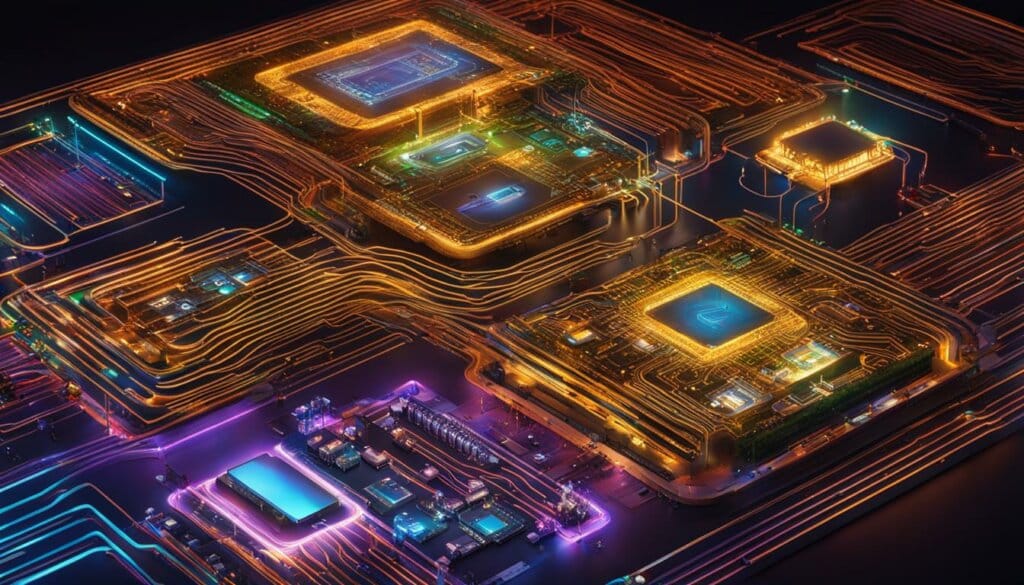
Medical Benefits of Nanotechnology
Nanotechnology holds significant promise in the field of medicine. It offers the potential for advancements in surgeries, such as the use of nanobots to clear blockages in arteries and to repair injuries on a cellular level. The precise control and maneuverability of nanobots enable surgeons to navigate through delicate tissues and perform minimally invasive procedures, resulting in reduced recovery time and improved patient outcomes.
One of the key medical benefits of nanotechnology is its ability to revolutionize drug production. By tailoring drugs at a molecular level, scientists can enhance their effectiveness and reduce side effects. This targeted drug delivery approach ensures that medications reach specific cells or tissues, increasing their efficiency while minimizing potential harm to healthy cells.
Another exciting development in nanotechnology is the use of smart bandages. Researchers have developed bandages embedded with carbon nanotubes that can detect and monitor infections. These intelligent bandages can assess the presence and progression of infections by measuring changes in electrical conductivity. By providing real-time data, smart bandages empower healthcare professionals to intervene promptly, improving wound management and reducing the risk of complications.
| Medical Benefits of Nanotechnology | Description |
|---|---|
| Enhanced Surgical Procedures | The use of nanobots enables precise and minimally invasive surgeries, resulting in faster recovery and improved outcomes. |
| Targeted Drug Delivery | Nanotechnology allows for the customization of drugs at a molecular level, making them more effective and reducing side effects. |
| Smart Bandages | Carbon nanotube-infused bandages can detect and monitor infections, providing real-time data for prompt intervention. |
The use of nanotechnology in medicine has the potential to revolutionize healthcare by enabling more precise diagnostic and therapeutic approaches. By harnessing the unique properties of materials at the nanoscale, researchers and medical professionals can improve patient outcomes and enhance the quality of life for individuals around the world.
Environmental Effects and Economic Issues
Nanotechnology has both positive and negative impacts on the environment. While there are concerns about the creation of new toxins and pollutants, experts have debunked exaggerated scenarios like the “gray goo” scenario, which were based on unfounded fears.
On the positive side, nanotechnology has the potential to address environmental challenges by enabling the development of sustainable materials and clean energy solutions. For example, researchers are exploring the use of nanomaterials to improve the efficiency of solar panels and enhance energy storage systems. Nanotechnology can also contribute to pollution remediation and waste management through innovative nanosensors and nanocatalysts.
However, it is crucial to carefully evaluate and mitigate the potential environmental risks associated with nanotechnology. The manufacturing and disposal of nanomaterials may introduce new pollutants into the environment, raising concerns about their long-term effects on ecosystems and human health.
“Nanotechnology has the potential to revolutionize industries and improve the quality of life, but we must strike a balance between innovation and environmental responsibility.”
In addition to environmental effects, nanotechnology is expected to have significant implications for the economy. The integration of nanotechnology into various sectors is likely to drive economic growth and create new employment opportunities. However, it may also lead to job losses in industries that become obsolete as a result of new nanotechnology-driven advancements.
The economic impact of nanotechnology extends beyond job fluctuations. It will influence industries such as manufacturing, electronics, healthcare, and energy, with potential disruptions to existing markets and supply chains. Companies that fail to adapt to the changes brought about by nanotechnology may face significant challenges in remaining competitive.
To understand the economic implications of nanotechnology, let us consider the following table, highlighting the sectors that will be affected:
| Sector | Economic Effects |
|---|---|
| Manufacturing | Potential job losses in traditional manufacturing industries as new nanomaterials and manufacturing techniques become prevalent. |
| Electronics | Increased efficiency and performance of electronic devices, leading to market shifts and potential obsolescence of older technologies. |
| Healthcare | Development of advanced medical treatments and diagnostic tools, driving growth in the healthcare sector but potentially increasing healthcare costs. |
| Energy | Improved energy production and storage capabilities, leading to changes in energy markets and potential displacement of fossil fuel-based technologies. |
| Environmental Remediation | New opportunities for pollution mitigation and waste management, potentially creating new markets and driving green technology adoption. |
It is essential for policymakers and stakeholders to proactively address the economic challenges posed by nanotechnology. This includes investing in research and development, fostering innovation, and promoting educational programs to ensure a skilled workforce capable of adapting to the changing economic landscape.
By carefully managing the environmental effects and economic issues related to nanotechnology, society can fully harness its potential while minimizing any negative consequences. Striking a balance between innovation, environmental sustainability, and economic stability will be key to a successful and responsible implementation of nanotechnology.
Potential Security Threats
Nanotechnology has brought about numerous advancements in various industries, but its potential security threats cannot be overlooked. The ability to manipulate matter at the atomic and molecular scale poses unique risks that need to be addressed.
One major concern is the possibility of microscopic recording devices, which could be used for surveillance purposes. While these devices may have legitimate applications such as law enforcement or monitoring public spaces, there is also a significant risk of misuse and invasion of privacy. The ability to record and monitor individuals at such a small scale raises questions about the ethical implications and boundaries of surveillance.
Furthermore, the weaponization of nanotechnology is another potential security threat. Nanotechnology has the potential to contribute to the development of more advanced weapons, such as computerized bullets. These bullets can be controlled and aimed with precision, posing a significant risk in the wrong hands. The increasing sophistication of weaponry and the ease of access to nanotechnology raise concerns about the potential for misuse and the destabilization of global security.
“Nanotechnology brings with it great power and responsibility. We must be proactive in addressing the potential security threats associated with its development to ensure a safe and secure future.” – Dr. Emily Watson, Nanotechnology Researcher
It is essential to prioritize research and development of security measures to mitigate the potential risks of nanotechnology. This includes implementing adequate safeguards in the design and production process to prevent unauthorized use or manipulation of nanotechnology. Additionally, international cooperation and regulation are crucial to address the global implications of nanotechnology security threats.
| Security Threat | Description |
|---|---|
| Microscopic recording devices | Devices capable of surveillance at the atomic and molecular scale. |
| Weaponization of nanotechnology | Development of advanced weapons utilizing nanoscale materials and technologies. |
| Invasion of privacy | Potential misuse of nanotechnology for unauthorized surveillance and monitoring. |
| Destabilization of global security | Risk of increased proliferation of advanced weaponry and potential conflicts. |
By addressing potential security threats and enacting appropriate measures, we can harness the benefits of nanotechnology while minimizing its risks. Continued research, collaboration, and responsible development within the field are essential for ensuring a safe and secure future.
Definition of Nanotechnology
Nanotechnology involves understanding and manipulating matter at the atomic and molecular scale. It encompasses nanoscale science, engineering, and technology, focusing on materials and phenomena that occur at sizes between 1 and 100 nanometers. Nanotechnology has opened up new possibilities in various fields, enabling scientists to see, calculate, model, and control materials at the nanoscale.

How Nanotechnology Works
Nanotechnology is based on the principle that when materials are reduced to the nanoscale, their physical and chemical properties change. At this scale, quantum effects, surface area-to-volume ratios, and other unique phenomena come into play, allowing for unprecedented control and manipulation of matter. Scientists use various tools and techniques, such as scanning tunneling microscopes and molecular self-assembly, to study and engineer materials at the nanoscale.
Applications in Various Fields
Nanotechnology has widespread applications across numerous disciplines:
- In medicine, nanotechnology enables targeted drug delivery, non-invasive diagnostics, and regenerative therapies.
- In electronics, nanotechnology has led to smaller and more powerful devices, such as transistors and memory chips.
- In energy, nanotechnology facilitates the development of efficient solar cells, energy storage systems, and fuel cells.
- In environmental science, nanotechnology offers solutions for pollution remediation, water purification, and sustainable agriculture.
- In materials science, nanotechnology has led to the creation of stronger, lighter, and more durable materials with enhanced properties.
“With nanotechnology, we are actually able to manipulate matter at the molecular level. This opens up a whole new world of possibilities for industries ranging from healthcare to electronics.” – Dr. Elizabeth Thompson, Nanotechnology Researcher
As researchers continue to explore the potential of nanotechnology, new applications and discoveries are constantly being made. From targeted cancer therapies to ultra-thin flexible displays, nanotechnology is revolutionizing how we interact with the world around us.
Advancements in Research and Market Value
The field of nanotechnology is experiencing rapid advancements, driving innovation and economic growth across various industries. With governments and organizations worldwide investing significant resources in nanotechnology research and development, the market value of nanotechnology-based products is projected to reach a staggering $1 trillion by 2015.
This substantial investment reflects the high expectations for nanotechnology and its potential to revolutionize multiple sectors, including manufacturing, energy, medicine, and electronics. Researchers and scientists are leveraging nanotechnology’s unique properties to create novel materials, develop advanced manufacturing processes, and improve the efficiency of energy production.
Advancements in nanotechnology research are paving the way for groundbreaking medical treatments. By harnessing nanoscale science and technology, medical professionals can target diseases at a cellular level, develop more effective drug delivery systems, and even create smart bandages capable of detecting and monitoring infections.
About nanotechnology’s market value, the immense potential for growth has led to unprecedented investments in research and development. Governments are allocating considerable funding to support nanotechnology initiatives, recognizing its crucial role in driving economic growth, innovation, and job creation.
“The market value projections for nanotechnology underscore the immense potential it holds for transforming industries and improving our quality of life. With advancements in research, nanotechnology is set to revolutionize manufacturing, energy production, healthcare, and beyond.”
As nanotechnology continues to evolve, researchers are striving to address challenges such as potential health risks and ethical considerations. It is essential to establish safety protocols to minimize occupational and environmental exposure to nanoparticles, ensuring the responsible and sustainable use of nanomaterials.
In conclusion, the rapid advancements in nanotechnology research coupled with its projected market value of $1 trillion by 2015 highlight the immense opportunities and high expectations surrounding this field. By investing in nanotechnology, governments and organizations are driving innovation, economic growth, and paving the way for a future full of remarkable advancements across industries.
Potential Health Risks and Ethical Considerations
Although nanotechnology offers numerous benefits across various fields, it also raises concerns about potential health risks associated with exposure to nanoparticles. These ultrafine particles, ranging in size from 1 to 100 nanometers, can possess unique surface properties that have the potential to interact with biological systems in unexpected ways.
Nanoparticles have the ability to be inhaled or absorbed by the body, and their small size allows them to penetrate deep into tissues, including vital organs like the lungs and brain. This raises concerns about the potential toxic effects that nanoparticles may induce when interacting with human cells and tissues.
Evidence from studies conducted in laboratories has shown that certain nanoparticles can cause oxidative stress, inflammation, and even DNA damage in cells. The toxic effects of nanoparticles depend on various factors, such as particle size, shape, surface area, chemical composition, and the duration and intensity of exposure.
Given the wide use of nanomaterials in consumer products, occupational settings, and environmental applications, it is crucial to address the potential health risks associated with nanotechnology. Researchers and regulatory bodies are actively working to understand the safety profiles of nanomaterials and develop appropriate guidelines for their use.
“Nanoparticles have the potential to interact with biological systems in unexpected ways, raising concerns about their potential toxic effects and long-term health implications.” – Dr. Alice Turner, Nanotechnology Researcher
Occupational Exposure and Worker Safety
One ethical consideration regarding nanotechnology is the occupational exposure of workers involved in nanomaterial production and handling. Industries that work with nanomaterials, such as manufacturing, pharmaceuticals, and electronics, must take measures to protect workers from potential hazards.
Employers should prioritize the implementation of engineering controls, such as enclosed systems and ventilation, to minimize the release of nanoparticles into the working environment. Personal protective equipment (PPE), including respirators and gloves, is essential to reduce direct exposure to nanomaterials.
Environmental Exposure and Ecosystem Impacts
Another ethical consideration revolves around the potential environmental exposure and associated impacts on ecosystems. Nanoparticles can find their way into the environment through various pathways, including wastewater discharge, product disposal, and accidental releases during manufacturing processes.
Researchers are studying the fate and transport of nanoparticles in the environment, as well as their potential ecological effects. It is crucial to understand the long-term consequences of nanoparticle accumulation in soil, water, and organisms to minimize any negative environmental impacts and ensure sustainable use of nanomaterials.
Precautionary Measures and Risk Assessment
Addressing the potential health risks associated with nanotechnology requires the adoption of precautionary measures and risk assessment strategies. Regulatory bodies and research institutions play a vital role in ensuring the safe development, production, and use of nanomaterials.
Implementing a comprehensive risk assessment framework involves identifying potential hazards, evaluating exposure pathways, and assessing toxicity. This information is crucial in establishing exposure limits, safety guidelines, and control measures to protect human health and the environment.
Public Awareness and Engagement
Public awareness and engagement are essential in navigating the ethical considerations surrounding nanotechnology. Open dialogue between scientists, policymakers, industry stakeholders, and the general public can promote transparency, address concerns, and facilitate informed decision-making.
An educated society can weigh the benefits and risks of nanotechnology, ensuring that scientific advancements align with societal values and expectations. Responsible innovation and governance frameworks can help strike a balance between harnessing the potential of nanotechnology while minimizing potential harm.
By prioritizing health and safety, implementing effective risk management strategies, and fostering public engagement, we can embrace the potential of nanotechnology while addressing the ethical considerations associated with its use.
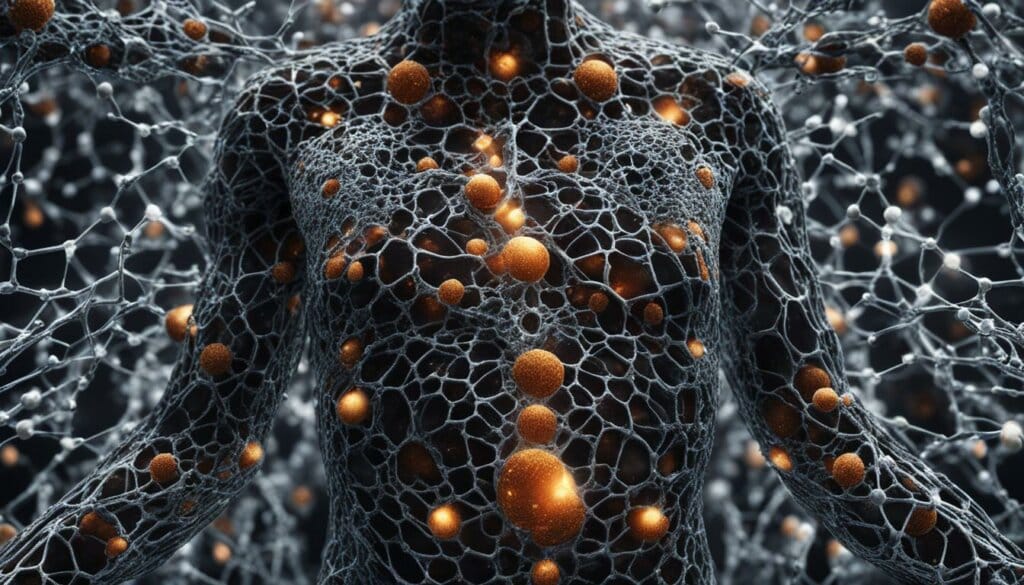
Conclusion
Nanotechnology has emerged as a powerful force with the potential to reshape various industries and improve the overall quality of life. The advantages of nanotechnology are evident in fields such as manufacturing, energy, medicine, and electronics. By harnessing the unique properties of nanomaterials, researchers and engineers have developed innovative products and techniques that were once unimaginable.
However, it is important to acknowledge the potential drawbacks and risks associated with nanotechnology. Environmental effects, economic disruptions, security concerns, and potential health risks are challenges that need to be addressed. Continuous research and monitoring are necessary to harness the benefits while mitigating any negative consequences.
In conclusion, the pros and cons of nanotechnology paint a complex picture. While the advantages are evident, it is crucial to approach its development with caution and responsibility. By doing so, we can maximize the potential benefits of nanotechnology while ensuring the well-being of society and the environment.
FAQ
What are the advantages and disadvantages of nanotechnology?
Nanotechnology offers various advantages such as the potential for faster computers, more efficient power sources, and life-saving medical treatments. However, there are also potential disadvantages, including economic disruption and concerns about security, privacy, health, and the environment.
What are the manufacturing advantages of nanomaterials?
Nanotechnology is revolutionizing manufacturing by creating new materials such as nanotubes, nanoparticles, and aerogels. These materials have unique properties and can be used to develop novel techniques and superior products. Nanobots and nanofactories also have the potential to construct new materials and objects, paving the way for advancements in manufacturing processes.
What are the energy and electronic advantages of nanotechnology?
Nanotechnology has the potential to transform energy production and the electronics industry. It can make solar power more economical by reducing the cost of constructing solar panels, leading to more efficient energy storage devices. Nanotechnology also enables the construction of circuits on an atomic level, enhancing the capabilities of electronic devices such as display screens and lighting.
What are the medical benefits of nanotechnology?
Nanotechnology holds significant promise in the field of medicine. It offers the potential for advancements in surgeries, such as the use of nanobots to clear blockages in arteries and the repair of injuries on a cellular level. Nanotechnology can also improve drug production by tailoring drugs at a molecular level, making them more effective and reducing side effects. Additionally, researchers have developed smart bandages that can detect and monitor infections using carbon nanotubes.
What are the environmental effects and economic issues associated with nanotechnology?
Nanotechnology may have both positive and negative impacts on the environment. While there is concern about the creation of new toxins and pollutants, some exaggerated scenarios, such as the “gray goo” scenario, have been debunked by experts. Nanotechnology is expected to cause major changes in many economic areas, potentially leading to job losses and the obsolescence of certain technologies and materials.
What are the potential security threats of nanotechnology?
Nanotechnology raises concerns about security due to the possibility of microscopic recording devices and the potential weaponization of nanotechnology. While microscopic recording devices may have surveillance applications, there is also the risk of misuse and invasion of privacy. Furthermore, nanotechnology could contribute to the development of more advanced weapons, including computerized bullets that can be controlled and aimed accurately.
What is the definition of nanotechnology?
Nanotechnology involves understanding and manipulating matter at the atomic and molecular scale. It encompasses nanoscale science, engineering, and technology, focusing on materials and phenomena that occur at sizes between 1 and 100 nanometers. Nanotechnology has opened up new possibilities in various fields, enabling scientists to see, calculate, model, and control materials at the nanoscale.
What are the advancements in research and the market value of nanotechnology?
The field of nanotechnology is experiencing rapid advancements, and the market for products based on nanotechnology is projected to reach a value of $1 trillion by 2015. Governments and organizations around the world are investing significant resources in nanotechnology research and development. This investment reflects the high expectations for nanotechnology’s potential to drive innovation and economic growth.
What are the potential health risks and ethical considerations of nanotechnology?
Despite the numerous benefits of nanotechnology, there are concerns about potential health risks associated with exposure to nanoparticles. Nanoparticles can have unique surface properties and may exhibit toxic effects when inhaled or absorbed by the body. The ethical considerations surrounding nanotechnology involve minimizing occupational and environmental exposure and taking precautionary measures to ensure the safe use of nanomaterials.
What is the conclusion on the pros and cons of nanotechnology?
Nanotechnology offers significant advantages across various fields, including manufacturing, energy, medicine, and electronics. It has the potential to revolutionize industries and improve the quality of life. However, there are also potential disadvantages and risks, such as environmental effects, economic disruptions, and concerns about security and health. It is important to continue researching and monitoring the impact of nanotechnology to maximize its benefits while mitigating any potential negative consequences.





